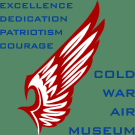Museum aircraft selection involved visits to a number of different bases.

In many cases, we were able to
pre-screen aircraft that we wanted to see. But old fashioned "Mark-1" eyeballs were used to make the final decisions.

Seeing the array of hardware that was ready to go to war provokes strong feelings and memories for the generations that grew up in the era. We hope a sense of history and understanding passes to the generations that follow.

Because aircraft of different types (and sometimes aircraft of the same type) were stored at different bases, the group had to go from base to base around the country. Because travel time took away from inspection time, the trips between bases were often made in a hurry. Texans, used to large
SUV's on super-highways found themselves crammed into smaller vehicles on smaller roads. While perhaps luxurious by local standards, the travel accommodations had them asking "are we there yet?".

The array of hardware was impressive. On the first visit, a base commander was reluctant to agree to the release of even a single aircraft. By the last visit, positions and responsibilities had changed and any and all were available (at a price).

Bord 122, in a field with sister ships was our first choice. Unfortunately, this was the unit that was damaged upon arrival.

The tallest member of the group, in the foreground, suffered patiently, folding himself back into the car as the group jumped from base to base.

And they drove,

and drove,

sometimes passing sights that were intriguing, wishing there was more time to stop and visit. The countryside was
beautiful and the people were polite and curious about the visitors that were interested in their country and their aircraft.

On some bases, aircraft were still in bomb-proof revetments, poised as if they were still on the ready line.

The museum's
Mig-21, Bord 38 is shown here as first seen during one of the base visits.
 In many cases, we were able to pre-screen aircraft that we wanted to see. But old fashioned "Mark-1" eyeballs were used to make the final decisions.
In many cases, we were able to pre-screen aircraft that we wanted to see. But old fashioned "Mark-1" eyeballs were used to make the final decisions. Seeing the array of hardware that was ready to go to war provokes strong feelings and memories for the generations that grew up in the era. We hope a sense of history and understanding passes to the generations that follow.
Seeing the array of hardware that was ready to go to war provokes strong feelings and memories for the generations that grew up in the era. We hope a sense of history and understanding passes to the generations that follow. Because aircraft of different types (and sometimes aircraft of the same type) were stored at different bases, the group had to go from base to base around the country. Because travel time took away from inspection time, the trips between bases were often made in a hurry. Texans, used to large SUV's on super-highways found themselves crammed into smaller vehicles on smaller roads. While perhaps luxurious by local standards, the travel accommodations had them asking "are we there yet?".
Because aircraft of different types (and sometimes aircraft of the same type) were stored at different bases, the group had to go from base to base around the country. Because travel time took away from inspection time, the trips between bases were often made in a hurry. Texans, used to large SUV's on super-highways found themselves crammed into smaller vehicles on smaller roads. While perhaps luxurious by local standards, the travel accommodations had them asking "are we there yet?". The array of hardware was impressive. On the first visit, a base commander was reluctant to agree to the release of even a single aircraft. By the last visit, positions and responsibilities had changed and any and all were available (at a price).
The array of hardware was impressive. On the first visit, a base commander was reluctant to agree to the release of even a single aircraft. By the last visit, positions and responsibilities had changed and any and all were available (at a price). Bord 122, in a field with sister ships was our first choice. Unfortunately, this was the unit that was damaged upon arrival.
Bord 122, in a field with sister ships was our first choice. Unfortunately, this was the unit that was damaged upon arrival. The tallest member of the group, in the foreground, suffered patiently, folding himself back into the car as the group jumped from base to base.
The tallest member of the group, in the foreground, suffered patiently, folding himself back into the car as the group jumped from base to base. And they drove,
And they drove, and drove,
and drove, sometimes passing sights that were intriguing, wishing there was more time to stop and visit. The countryside was beautiful and the people were polite and curious about the visitors that were interested in their country and their aircraft.
sometimes passing sights that were intriguing, wishing there was more time to stop and visit. The countryside was beautiful and the people were polite and curious about the visitors that were interested in their country and their aircraft. On some bases, aircraft were still in bomb-proof revetments, poised as if they were still on the ready line.
On some bases, aircraft were still in bomb-proof revetments, poised as if they were still on the ready line. The museum's Mig-21, Bord 38 is shown here as first seen during one of the base visits.
The museum's Mig-21, Bord 38 is shown here as first seen during one of the base visits.



No comments:
Post a Comment